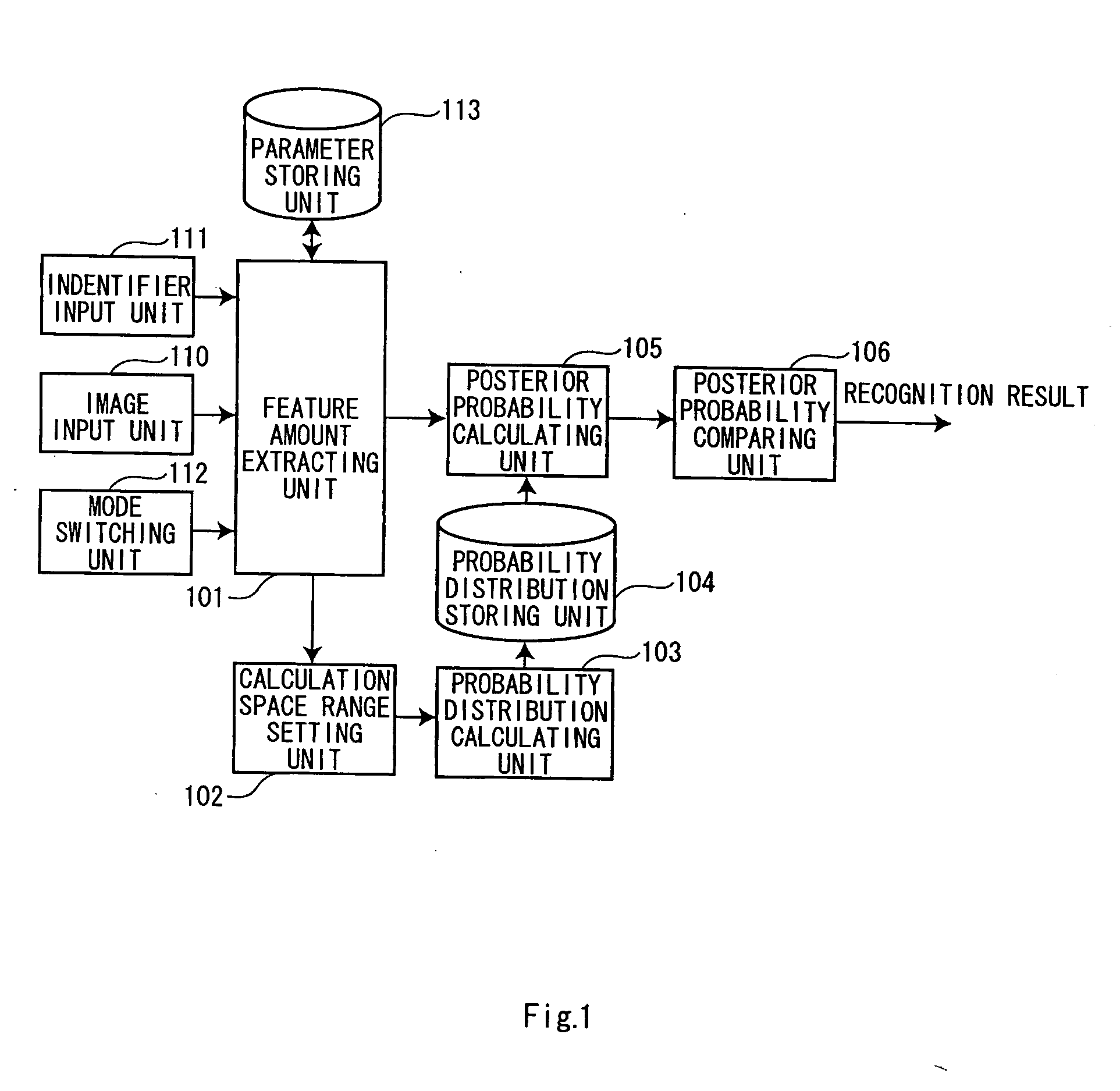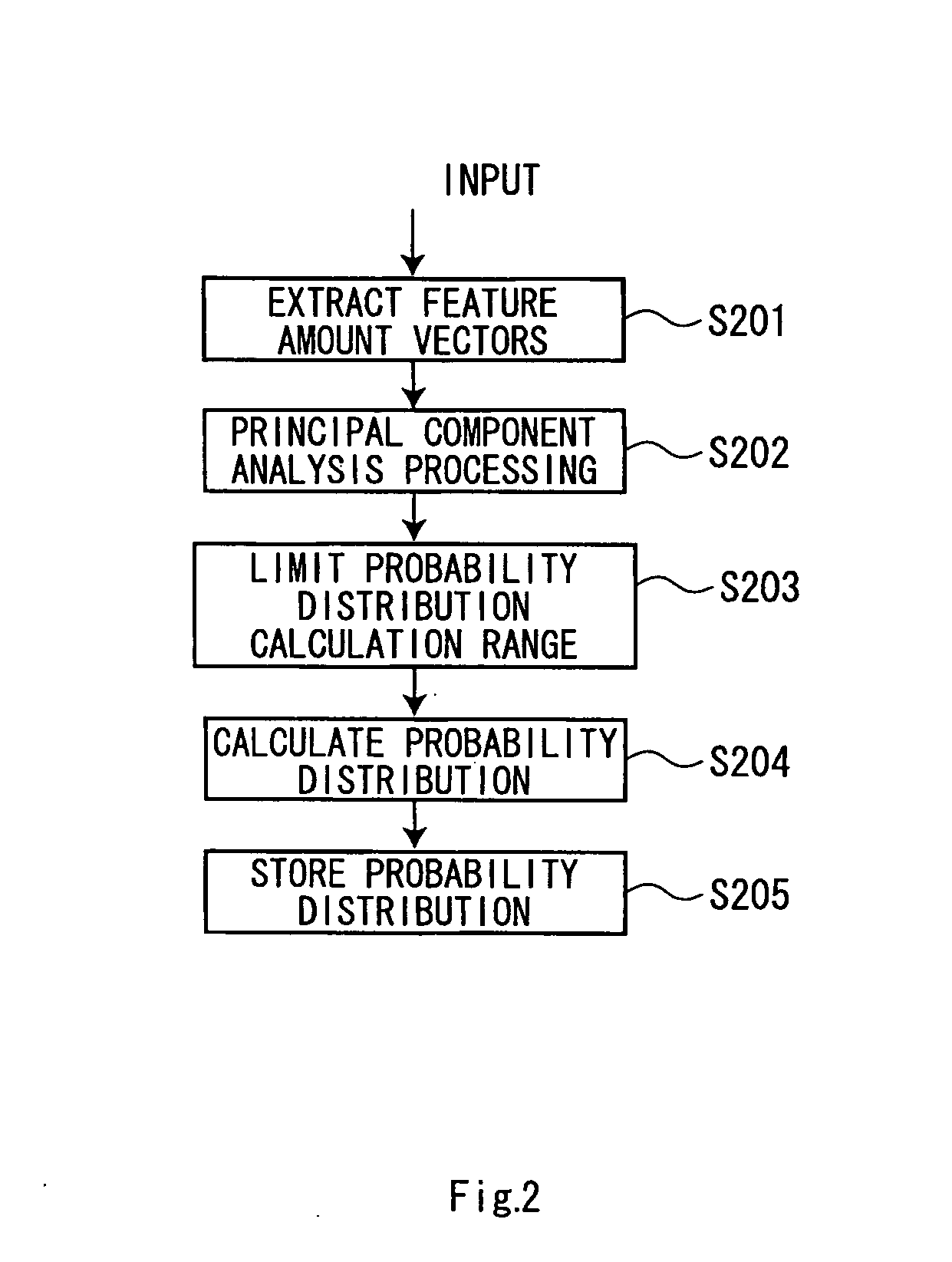Pattern recognition apparatus and pattern recognition method
a pattern recognition and pattern recognition technology, applied in speech recognition, speech analysis, instruments, etc., can solve the problems of difficulty in matching feature points, difficulty in positioning, and difficulty in clear definition of feature points
- Summary
- Abstract
- Description
- Claims
- Application Information
AI Technical Summary
Benefits of technology
Problems solved by technology
Method used
Image
Examples
first embodiment
[0029] A first embodiment of the invention will be hereinafter explained with reference to the accompanying drawings.
[0030]FIG. 1 is a block diagram of a pattern recognition apparatus in the first embodiment. The pattern recognition apparatus includes an image input unit 110 that inputs an image, an identifier input unit 111 that inputs identifiers of learning objects, a feature amount extracting unit 101 that extracts feature amount vectors of the image inputted and feature values the feature amount vectors, and a parameter storing unit 113 that stores data (information on the inputted image) used by the feature amount extracting unit 101 and data (parameters defining a feature amount vector space) generated by the feature amount extracting unit 101.
[0031] The pattern recognition apparatus also includes a calculation space range setting unit 102 that sets a range (a calculation space range), in which a probability distribution of the feature amount vectors is calculated in the fe...
second embodiment
[0081] A second embodiment of the invention will be hereinafter explained with reference to the accompanying drawings.
[0082] The pattern recognition apparatus in the first embodiment performs recognition by comparing a posterior probability of the class cj and posterior probabilities of other classes cg. However, it is not always possible to calculate feature amount vectors of all classes.
[0083] In the case of a monitoring system that recognizes and distinguishes a normal state and an abnormal state, it is easy to obtain a feature amount vector of a normal state class c0 corresponding to the normal state. However, it is not rare that it is difficult to obtain a feature amount vector of an abnormal state class cI corresponding to the abnormal state. For example, it is not realistic to set fire to a building being monitored in order to cause a system for monitoring a building to learn a fire state.
[0084] In the case of such a system, processing for judging that a state is abnormal ...
third embodiment
[0094] A third embodiment of the invention will be hereinafter explained with reference to the accompanying drawings.
[0095] The recognition methods based on a posterior probability explained in the first and the second embodiments is the nonparametric method of not assuming a distribution model of a pattern. In these methods, as the amount of learning data increases, the performance increases and generally the method requires a relatively large number of learning data in order to obtain high performance.
[0096] On the other hand, in the parametric method represented by the subspace method, rather high performance is often obtained even if an amount of learning data is relatively small.
[0097] Thus, in the pattern recognition apparatus in this embodiment, improvement and stabilization of recognition performance are realized by combining other methods (e.g., the parametric method) with the pattern recognition apparatuses in the first and the second embodiments.
[0098]FIG. 11 is a blo...
PUM
 Login to View More
Login to View More Abstract
Description
Claims
Application Information
 Login to View More
Login to View More - R&D
- Intellectual Property
- Life Sciences
- Materials
- Tech Scout
- Unparalleled Data Quality
- Higher Quality Content
- 60% Fewer Hallucinations
Browse by: Latest US Patents, China's latest patents, Technical Efficacy Thesaurus, Application Domain, Technology Topic, Popular Technical Reports.
© 2025 PatSnap. All rights reserved.Legal|Privacy policy|Modern Slavery Act Transparency Statement|Sitemap|About US| Contact US: help@patsnap.com



